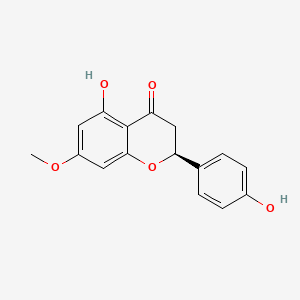| MeSH term | MeSH ID | Detail |
|---|---|---|
| Acne Vulgaris | D000152 | 35 associated lipids |
Sakuranetin
Sakuranetin is a lipid of Polyketides (PK) class. Sakuranetin is associated with abnormalities such as and Neurodegenerative Disorders. The involved functions are known as inhibitors, Drug Interactions, aldehyde reductase activity, Antiinflammatory Effect and antagonists. Sakuranetin often locates in Vacuole and Cell surface. The associated genes with Sakuranetin are PTPN1 gene.
Cross Reference
Introduction
To understand associated biological information of Sakuranetin, we collected biological information of abnormalities, associated pathways, cellular/molecular locations, biological functions, related genes/proteins, lipids and common seen animal/experimental models with organized paragraphs from literatures.
What diseases are associated with Sakuranetin?
Sakuranetin is suspected in Neurodegenerative Disorders and other diseases in descending order of the highest number of associated sentences.
Related references are mostly published in these journals:
| Disease | Cross reference | Weighted score | Related literature |
|---|
Possible diseases from mapped MeSH terms on references
We collected disease MeSH terms mapped to the references associated with Sakuranetin
PubChem Associated disorders and diseases
What pathways are associated with Sakuranetin
There are no associated biomedical information in the current reference collection.
PubChem Biomolecular Interactions and Pathways
Link to PubChem Biomolecular Interactions and PathwaysWhat cellular locations are associated with Sakuranetin?
Visualization in cellular structure
Associated locations are in red color. Not associated locations are in black.
Related references are published most in these journals:
| Location | Cross reference | Weighted score | Related literatures |
|---|
What functions are associated with Sakuranetin?
Related references are published most in these journals:
| Function | Cross reference | Weighted score | Related literatures |
|---|
What lipids are associated with Sakuranetin?
There are no associated biomedical information in the current reference collection.
What genes are associated with Sakuranetin?
Related references are published most in these journals:
| Gene | Cross reference | Weighted score | Related literatures |
|---|
What common seen animal models are associated with Sakuranetin?
There are no associated biomedical information in the current reference collection.
NCBI Entrez Crosslinks
All references with Sakuranetin
Download all related citations| Authors | Title | Published | Journal | PubMed Link |
|---|---|---|---|---|
| Medić-Sarić M et al. | From functional food to medicinal product: systematic approach in analysis of polyphenolics from propolis and wine. | 2009 | Nutr J | pmid:19624827 |
| Alam P et al. | Inter-species comparative antioxidant assay and HPTLC analysis of sakuranetin in the chloroform and ethanol extracts of aerial parts of Rhus retinorrhoea and Rhus tripartita. | 2017 | Pharm Biol | pmid:28345446 |
| Balijepalli MK et al. | Antiproliferative activity and induction of apoptosis in estrogen receptor-positive and negative human breast carcinoma cell lines by Gmelina asiatica roots. | 2010 | Pharmacognosy Res | pmid:21808551 |
| Danelutte AP et al. | Antifungal flavanones and prenylated hydroquinones from Piper crassinervium Kunth. | 2003 | Phytochemistry | pmid:12943774 |
| Ahmed MS et al. | A weakly antimalarial biflavanone from Rhus retinorrhoea. | 2001 | Phytochemistry | pmid:11576606 |
| Park HL et al. | Transcriptomic analysis of UV-treated rice leaves reveals UV-induced phytoalexin biosynthetic pathways and their regulatory networks in rice. | 2013 | Phytochemistry | pmid:24035516 |
| Funari CS et al. | Interconverting flavanone glucosides and other phenolic compounds in Lippia salviaefolia Cham. ethanol extracts. | 2011 | Phytochemistry | pmid:21871644 |
| Tuchinda P et al. | Anti-inflammatory cyclohexenyl chalcone derivatives in Boesenbergia pandurata. | 2002 | Phytochemistry | pmid:11809452 |
| Pacciaroni Adel V et al. | Antifungal activity of Heterothalamus alienus metabolites. | 2008 | Phytother Res | pmid:18386258 |
| Drira R and Sakamoto K | Sakuranetin Induces Melanogenesis in B16BL6 Melanoma Cells through Inhibition of ERK and PI3K/AKT Signaling Pathways. | 2016 | Phytother Res | pmid:27000529 |
